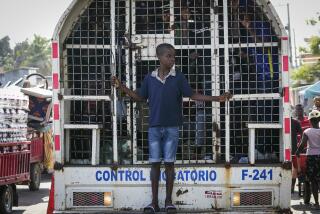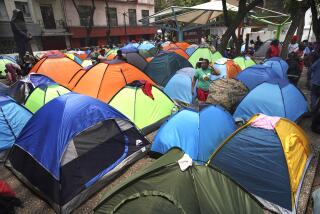In Caribbean, the Desperate Try Island-Hopping
MICHES, Dominican Republic — Ramonita de Jesus never made it to a better life. Nor did her husband, Manuel Reyes.
They drowned a year apart crossing the treacherous waters from the Dominican Republic to Puerto Rico -- just two among the many islanders who perish every year in the constant ebb and flow of illegal immigration across the Caribbean.
Yet the lure of prosperity beyond the horizon never dims. Over the last year, the number of boat people picked up in the Caribbean by the U.S. Coast Guard has doubled.
“There is nothing here,” said Augustina Paulino, Reyes’ mother, her eyes filling with tears. She said poverty and a lack of jobs drove the couple to risk the crossing -- her daughter-in-law in 2000, her son in 2001 -- leaving her to rear their three children in her wooden shack.
The dead can’t be reliably counted, although they are in the hundreds over the last few years. Boat people picked up alive by the Coast Guard are at their most numerous since 1996 -- more than 5,300 in the 12 months ending Sept. 30, including about 2,000 Haitians, 1,700 Dominicans and 1,500 Cubans.
They go by motorboat, sailboat or makeshift rafts, most often bound for the United States, although the wealthier Caribbean islands also wrestle with waves of illegal immigrants.
Haitians regularly crowd onto sailboats bound for the Bahamas. Cubans pay smugglers to whisk them to the Florida Keys, and others trickle in from South America and beyond -- lately even China -- island-hopping in hopes of eventually reaching the U.S. mainland.
Most of those caught are sent home. Others reach an island undetected, often sunburned and dehydrated, and move in with relatives or acquaintances until they find work or arrange the next leg of their journey.
Smuggling operations are well established and depend on whatever the market will bear. It’s $2,000 for the 100-mile passage from the Dutch territory of St. Maarten to the British Virgin Islands, one of many stop-off points for those trying to reach U.S. shores.
The fare for the Dominican-Puerto Rican run across the 75-mile Mona Passage ranges from $200 to more than $600 aboard a “yola,” or wooden motorboat. Smugglers build the crafts in the coastal forests and launch them at night to evade detection by Dominican navy patrols.
More than 300 people, many of them Dominicans, have died or are missing in illegal voyages bound for Puerto Rico or the U.S. Virgin Islands in the last three years, according to U.S. Border Patrol records.
But the payoff for those who make it can be great and, when night descends, the open ocean beckons the poor and desperate.
Paulino’s oldest son, Ramon Reyes, was the first to leave, crossing to Puerto Rico in 1999. The U.S. territory has a large population of Dominican immigrants, often doing grueling work for low pay. Construction jobs earn Reyes enough to wire his mother about $80 every two weeks.
“I make the effort to send them something even if I don’t have anything left,” said Reyes, 36, who married a Puerto Rican and is applying for legal U.S. residency. “Thanks to God I made it here.”
Most people have no steady work in the countryside where Reyes grew up, near the town of Miches on the northeastern Dominican coast.
His sister-in-law, Ramonita de Jesus, went down with about 40 others when their boat sank near the tiny island of Desecheo off Puerto Rico. Her body was never found.
Her husband, Manuel Reyes, tried to support their three children doing farm work, but it wasn’t enough. When he decided to leave for Puerto Rico in 2001, he told his mother not to worry.
“When I go to Puerto Rico, you won’t have to work because I’ll send you everything,” Paulino recalled him telling her. “I’ll send you clothes and food for the kids.”
He was among about 50 people who disappeared when their boat sank off the coast.
U.S. Border Patrol officials say the number of Dominicans detained after landing illegally in Puerto Rico has roughly doubled in the last year to 1,585. But that’s well below the 3,000 caught annually in the early 1990s, when the Dominican economy was in crisis.
The numbers began falling in 1995 as the economy grew and the Coast Guard stepped up patrols.
Now the Dominican economy is stagnating again. And the peso has fallen sharply, raising the cost of even basic foods and hitting the poor hardest.
Island-hopping has long been common in the Caribbean, dictated by economics or political upheaval, or both, as the cases of Haiti and Cuba regularly demonstrate.
Today, economics appears to drive most voyages -- the temptation felt by many when they see migrants who reach the United States send back money or return to their native islands and build luxurious houses.
Patricia Pessar, an associate professor of American studies and anthropology at Yale University, laments that in poor areas of the Dominican Republic, braving the sea for a better life is seen almost as a rite of passage -- “a sense that if you don’t try it, you’re someone without drive.”
More to Read
Sign up for Essential California
The most important California stories and recommendations in your inbox every morning.
You may occasionally receive promotional content from the Los Angeles Times.










